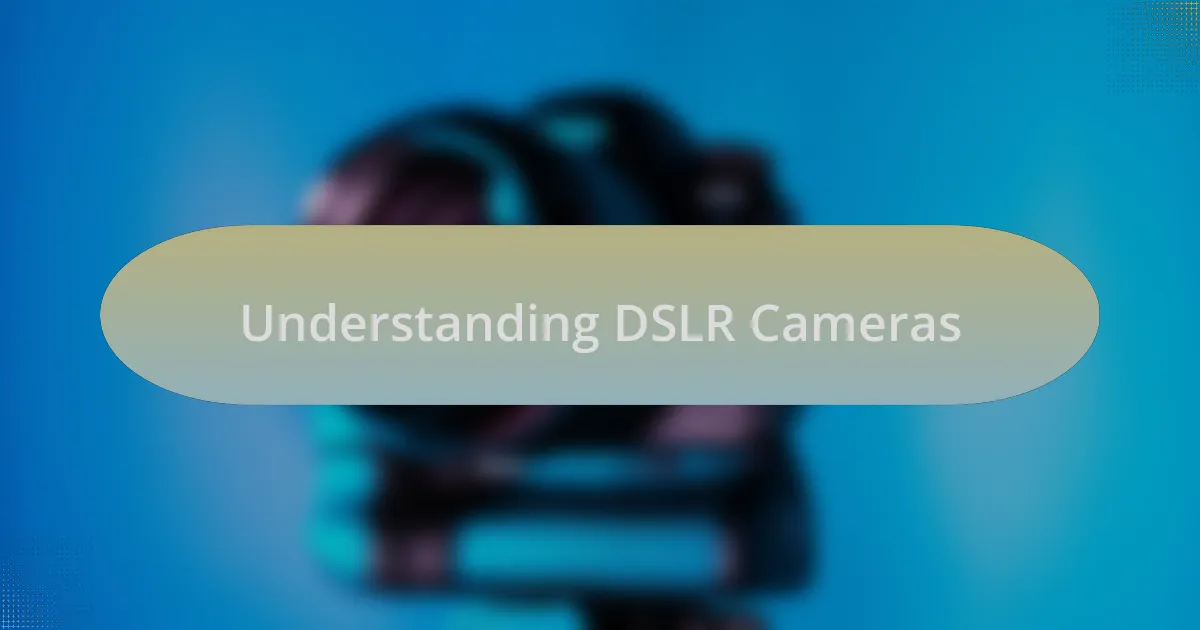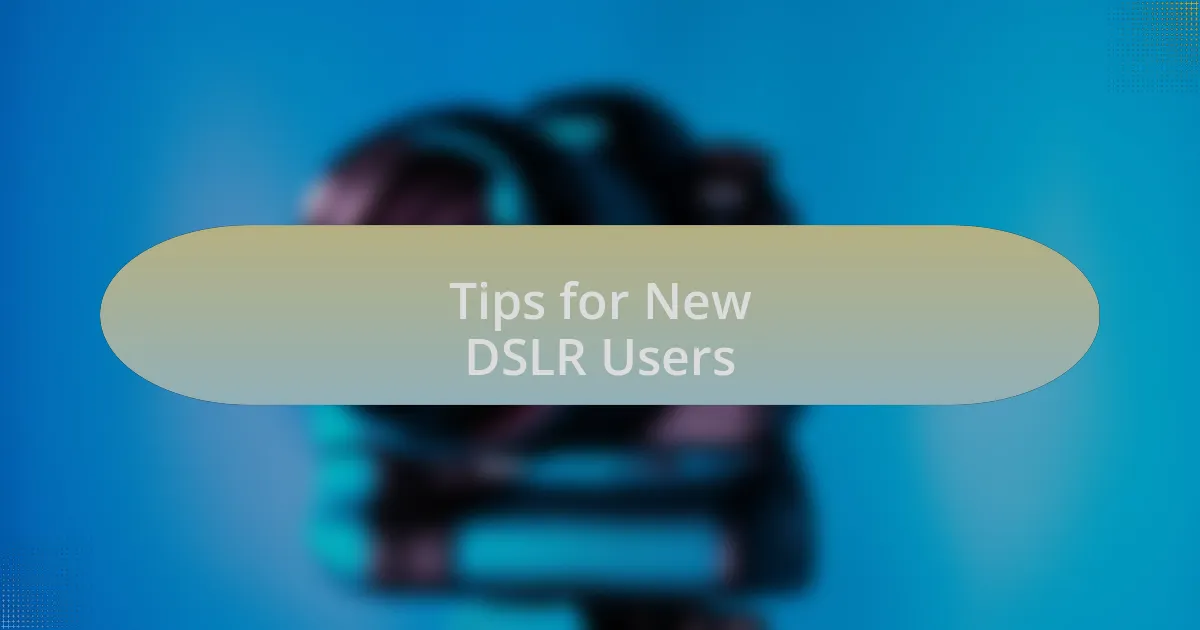Key takeaways:
- Understanding DSLR cameras involves recognizing key features like sensor size, autofocus systems, and ergonomic design for a better shooting experience.
- Researching different models and reading user experiences are essential steps in selecting the right camera, focusing on build quality and customization options.
- Hands-on experience and experimentation are crucial for new users to grasp the camera’s capabilities and improve their photography skills.

Understanding DSLR Cameras
A DSLR, or Digital Single-Lens Reflex camera, combines the convenience of digital technology with the versatility of interchangeable lenses. I remember the first time I held one; the weight felt reassuring, the viewfinder promised clarity. It’s exciting to think about how light travels through the lens and reflects off the mirror before reaching the sensor, capturing each moment with remarkable detail.
When I decided to explore photography more seriously, understanding the function of the lens was crucial. For instance, a wider aperture (lower f-stop number) not only allows more light in but can also create stunning backgrounds that draw focus to the subject. Have you ever noticed how a photograph can tell a story simply by how the background blurs? That’s the magic of depth of field, and it’s something that DSLR cameras excel at.
Getting to know a DSLR can feel overwhelming at first. With various settings and modes, it’s easy to question what each knob and button does. I often found myself experimenting right in my living room, capturing everything from my pets to the afternoon light. This hands-on experience was essential and reaffirmed that learning through practice is one of the most effective ways to connect with your camera.

Key Features to Consider
When I was choosing my first DSLR, I quickly realized that sensor size was a key feature that greatly impacts image quality. A larger sensor typically captures more light, which translates into better performance in low-light conditions. I remember taking my camera outside during golden hour, and the difference in texture and detail from a full-frame sensor was stunning.
Another essential feature to consider is the autofocus system. I recall trying to photograph my daughter during her first soccer game, and I was amazed at how quickly and accurately the camera could lock onto her movements. I learned that a camera with a robust autofocus system can help capture those fleeting moments without missing a beat. Have you ever tried to snap a photo of something moving fast, only to find it blurry? The right autofocus can change that.
Lastly, I found that the ergonomic design and intuitive controls were crucial for my shooting experience. Holding a camera for extended periods can be tiring, so I paid attention to how it felt in my hands. When I went to a local camera shop, I tested a few models, and the one that felt just right became an extension of me. This connection made all the difference in how comfortable I felt while exploring different settings and experimenting with my photography.

Researching Different DSLR Models
Researching different DSLR models became a journey in itself for me. I started by browsing online reviews and forums, diving into user experiences that really resonated with me. I remember reading about a specific model that seemed to capture the essence of low-light photography, which had been my biggest concern. Have you ever been captivated by the stunning night shots in someone else’s portfolio and wondered how they achieved that?
I also found myself exploring comparison videos on YouTube, where photographers shared their real-life experiences with various models. One review stuck with me: a photographer talked about the importance of build quality, emphasizing how durability affects your shooting in different environments. This speech ignited a spark—I recalled how I once took my camera on a hike, and the fear of damaging it made me realize I needed something that could withstand a bit of rough handling.
As I compiled my own list of must-have features, I paid attention to how many customization options each DSLR offered. I still vividly recall a conversation with a fellow photography enthusiast who stressed the importance of controls that suit your shooting style. It made me think—how can one truly make art if the tools don’t reflect your unique approach? This realization pushed me to prioritize models that offered flexibility, ultimately paving the way for my creative vision.

My Personal Experience with Selection
Selecting my first DSLR was quite an emotional roller coaster. I can still remember standing in the camera store, feeling overwhelmed by the variety of options. I was initially drawn to a model with a sleek design, but as soon as I picked it up, I felt an immediate connection—the weight and grip felt just right in my hands. Have you ever experienced that moment when you know something is meant for you?
A pivotal moment came when I realized the significance of the lens options. I recall chatting with a seasoned photographer who shared how his choice of lens transformed his photography game entirely. Inspired, I started to imagine the types of shots I could create, from sweeping landscapes to intimate portraits. This fueled my excitement, and I began to see the potential in each model based on the lens compatibility and quality. Wasn’t it fascinating to think that the right lens could unlock a whole new world of creativity?
Eventually, it wasn’t just about the features—it became about how the camera felt in relation to my passion. I specifically remember the day I finally settled on a model. I took it outdoors to test it out, and the first click of the shutter felt like a dream come true. That instant satisfaction I felt when capturing the perfect shot confirmed that I’d not only chosen a camera but had also embraced a new adventure in my photography journey.

Tips for New DSLR Users
When you first pick up a DSLR, it’s easy to get lost in the technical jargon and endless settings. My advice? Start with the basics. Familiarize yourself with your camera’s body and buttons. The first time I played with my camera, I spent hours simply adjusting the aperture and shutter speed, trying to understand how they affected my images. Have you ever felt that joy of watching a photo evolve with each tweak? It’s truly rewarding.
Another tip I wish I had prioritized early on is mastering the exposure triangle—aperture, shutter speed, and ISO. Understanding how these elements interact can elevate your photography significantly. I remember the first time I captured a sunset; I diligently adjusted these settings and watched in awe as the colors came alive. It was a revelation! Seeing your photos improve through small adjustments can motivate you to learn even more.
Lastly, don’t shy away from experimentation. There were days when I took mundane subjects and tried different angles or lighting, initially feeling silly but eventually discovering unique perspectives. Each click brought with it a lesson and a thrill, reminding me that photography is as much about exploration as it is about technique. How often do we get caught up in rules when the best discoveries lie right outside them? Embrace the journey!